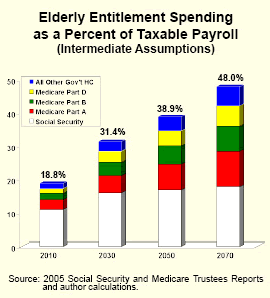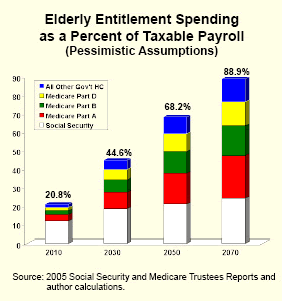Every year, the Social Security and Medicare Trustees examine the short- and long-term health of these programs, and issue reports that highlight the financial burdens they will create for future generations if nothing is done to reform them. This year's reports show Social Security and Medicare will consume an ever-increasing portion of workers' incomes unless the government either breaks its promises to future retirees or makes significant changes to our elderly entitlement system.
Rising Payroll Tax Rates: Intermediate Projections. Social Security and Medicare Part A (Hospital Insurance) benefits are funded by a 15.3 percent payroll tax on wages (12.4 percent for Social Security; 2.9 percent for Medicare). Payouts to current retirees currently consume only 10.4 percent of payroll, so Social Security is running a small surplus and will continue to do so until 2017 – one year less than projected in last year's report – when it will dip into permanent and progressively larger debts. If we assume payroll tax rates rise to meet our funding obligations, the burden on future workers will be large:

- When today's college students reach retirement age in 2050, their children and grandchildren will face a payroll tax rate of about 16.8 percent to pay their Social Security benefits – a 37 percent increase over today's rate.
- When Medicare Part A is included, the payroll tax burden will rise to 24.5 percent – almost one of every four dollars workers will earn that year.
In addition to these two programs, taxpayers will also have to provide three quarters of Medicare Part B benefits (Supplementary Medical Insurance; participant premiums offset a quarter of the cost) and 88 percent of the cost of Medicare Part D, the newly enacted Medicare prescription drug program (participant premiums offset only about 12 percent of Part D costs). Also, taxpayers fund seniors' medical bills through other government programs, including Medicaid and the Veterans Health Administration.
Although the costs for all these programs are paid from general revenues and state transfers, they can be expressed as a percentage of taxable payroll:
- If the federal and state government shares of Medicare Part B and Part D are added to Social Security and Medicare Part A, the burden on workers will climb to 34.6 percent by 2050 – more than one in three dollars of taxable payroll.
- When other government-funded health care for the elderly (programs like Medicaid and the Veterans Administration) is added, the total burden will reach 38.9 percent by mid-century.
Thus, almost 40 percent of the wages workers earn in 2050 has already been committed to pay benefits promised under current law. That's before any bridges or highways are built and before any teachers' or police officers' salaries are paid. If any new entitlement benefits such as more generous prescription drug coverage or long-term care benefits are added, the future burden will be even higher.
Rising Payroll Tax Rates: Pessimistic Projections. Nor is this the worst that can happen. The estimates in Figure I are based on the Trustees' intermediate projections. Under their pessimistic projection, by 2050 the total amount needed to support elderly benefits will climb higher than 68 percent of taxable payroll, claiming more than two-thirds of the incomes of future workers. [See Figure II.]

The intermediate assumptions are touted as "most likely" to happen. However, the pessimistic assumptions may more accurately predict future health care expenditures. In recent years, medical cost inflation has been moderate compared to annual increases a few years ago. Many believe the recent lower inflation rate is temporary and that health care costs will soar.
Drain on General Revenues. The previous projections assume tax rates will rise to meet our obligations. Social Security and Medicare obligations could also be funded by cutting other government spending.
While the problems grow over time, they are beginning to take a toll now. For many years, Social Security and Medicare Part A have collected enough in payroll taxes to cover the costs of Social Security, Medicare A and Medicare B. However, this year, with the introduction of Medicare Part D and rising costs in all three programs, Social Security and Medicare will, for the first time, spend all they collect in payroll taxes, and drain money from general revenues. Last year, the programs consumed about $45 billion from general revenues. This year, the amount will be $54 billion; next year, it is projected to be $108 billion.
With each passing year, the drain will become larger – if there is no change in taxes or benefits. For example, the amount of general revenues needed to fund Social Security and Medicare benefits will double in less than five years. They will double again in another five years, so that 10 years from now, one in seven dollars collected in income taxes will be spent on elderly entitlements – in addition to all they will receive from payroll taxes.
- By 2030, about the midpoint of the baby boomer retirement years, the two programs will need more than half of all federal income taxes to fill the gap between payroll tax revenues and promised benefits.
- By 2050, Social Security and Medicare will require three in four income tax dollars collected, in addition to payroll taxes.
- By 2070, almost all federal income tax revenues will be needed to provide full promised Social Security and Medicare benefits.
Again, these figures are based on the intermediate projections, so the reality could be worse.
Social Security and Medicare Are Pay-As-You-Go. Elderly entitlement programs are in trouble precisely because they are based on pay-as-you-go financing. Every dollar in payroll taxes is spent. Nothing is saved. Nothing is invested. The payroll taxes contributed by today's workers pay the benefits of today's retirees. However, when today's workers retire, their benefits will be paid only if the next generation of workers agrees to pay even higher taxes.
What About the Trust Funds? Unfortunately, the Social Security and Medicare Trust Funds exist purely for accounting purposes – to keep track of surpluses and deficits in the inflow and outflow of money. Since the cash was spent on other federal projects, the accumulated Social Security surplus actually consists of paper certificates (nonnegotiable bonds) kept in filing cabinets in Social Security offices in West Virginia.
These bonds cannot be sold on Wall Street or to foreign investors. They can only be returned to the Treasury. In essence, they are little more than IOUs the government writes to itself.
Every payroll tax check signed by employers is written to the U.S. Treasury. Every Social Security benefit check comes from the U.S. Treasury. The trust funds neither receive money nor disburse it. Moreover, every asset of the trust funds is a liability of the Treasury. Summing over both agencies of government (the trust funds plus the Treasury), the balance is zero. For the Treasury to write a Social Security check, the government must first tax or borrow.
Matt Moore is a senior policy analyst with the National Center for Policy Analysis.